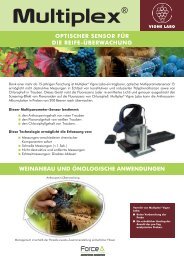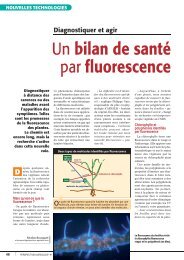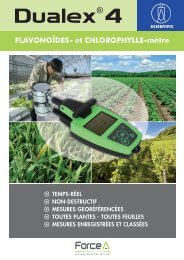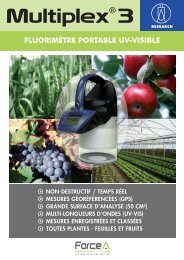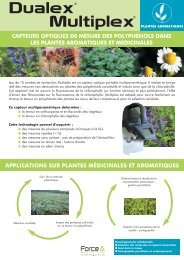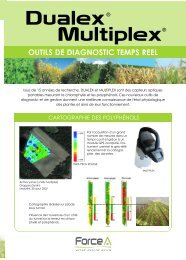DUALEX SCIENTIFIC - Force-A
DUALEX SCIENTIFIC - Force-A
DUALEX SCIENTIFIC - Force-A
Create successful ePaper yourself
Turn your PDF publications into a flip-book with our unique Google optimized e-Paper software.
<strong>DUALEX</strong> ® <strong>SCIENTIFIC</strong>, AN INNOVATIVE TOOL<br />
Resulting from a CNRS (National Center for Scientific Research) research team and the University of Paris-Sud in Orsay, this<br />
new leaf-clip can simultaneously and accurately monitor the chlorophyll content in leaves and flavonoid content in the epidermis.<br />
Versatile, it is dedicated to plant science and agronomy. Applied equally on monocots, dicots or perennials, this tool is simple<br />
to use. Measurements are instantaneous and non-destructive. They require no prior calibration, and no sample preparation.<br />
Therefore, measurements can either be done in the laboratory or in the field, in all conditions of temperature and ambient light.<br />
FLAVONOID measurement<br />
Epidermal flavonoids are absorbing UV light, and therefore<br />
they screen the chlorophyll underneath. FORCE-A uses this<br />
role of flavonoids as natural UV-filters to identify and<br />
quantify these molecules.<br />
CHLOROPHYLL measurement<br />
The leaf chlorophyll content can rapidly and accurately be<br />
assessed from light transmission. A first wavelength very close<br />
to the red 3 quantifies the chlorophyll and a second in the near<br />
infrared 4 can take into account the effects of leaf structure.<br />
Flavonoid absorption<br />
Absorption of leaves<br />
Chlorophyll<br />
Fluorescence<br />
1<br />
UV<br />
LED VIS<br />
2 3<br />
NIR<br />
4<br />
200 300 400 500 600 700 800 900<br />
A wavelength in the UV 1 is compared to a second wavelength<br />
in the red 2 . Both wavelengths excite the fluorescence of<br />
chlorophyll, but only UV is affected by the presence of flavonoids.<br />
By using these two wavelengths, the <strong>DUALEX</strong> ® <strong>SCIENTIFIC</strong><br />
calculates a numeric value directly correlated with chlorophyll<br />
content in the measured sample.<br />
Flavonoid absorbance = Log<br />
Infrared Fluo.<br />
excited by Red<br />
Infrared Fluo.<br />
excited by UV<br />
Chlorophyll content =<br />
Infrared Trans.<br />
Red Trans.<br />
Red Trans.<br />
The difference in chlorophyll fluorescence measured in the infrared<br />
is thus directly proportional to the amount of flavonoids present<br />
in the epidermis of the leaf.<br />
Sampling wavelength:<br />
UV-A<br />
EPIDERMIS:<br />
Rich in flavonoids<br />
MESOPHYLL:<br />
Rich in chlorophyll<br />
Reference wavelength:<br />
Red<br />
CHLOROPHYLL INDEX (<strong>DUALEX</strong><br />
INDICE CHLOROPHYLLE (<strong>DUALEX</strong>® ® 4)<br />
4)<br />
2009 season<br />
Partnership CIVC / FORCE-A / ESE<br />
Chardonnay and Pinot Noir (N=109)<br />
Differential measurement of fluorescence emitted by chlorophyll<br />
CHLOROPHYLLE<br />
Chlorophyll<br />
/



